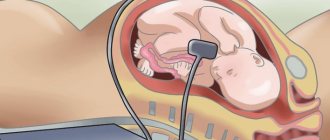How our body functions and what changes occur in it every month is always interesting. Especially during the period when we are pregnant or hope to become pregnant. We almost certainly never monitor our condition as carefully and closely as during the period when we hope to become pregnant. From feeling tired to feeling slightly nauseous, the smallest symptoms are studied and tested for their significance. In this article, we will look at some of the most common problems associated with implantation bleeding. This problem is frightening and confusing if the desired pregnancy has already occurred.
Thus, let's try to figure out what are the symptoms and signs of implantation bleeding, how to recognize the earliest signs of implantation and pregnancy? This self-control may be much stronger in people undergoing assisted fertility treatment, which is understandable. In this context, we will look at whether and how to expect any different implantation symptoms during pregnancy.
Other possible causes of bleeding in early pregnancy
Bleeding during early pregnancy may be due to causes other than implantation. If you have heavy bleeding in early pregnancy with or without cramping or pain, see your doctor.
Some of the other causes of bleeding in early pregnancy are:
- Intimate relationships.
May be one of the possible causes of bleeding in early pregnancy because the cervix is very sensitive at this stage. - Ectopic pregnancy
. This is a condition in which an embryo implants and develops somewhere else outside the uterus, such as the fallopian tubes, abdomen, ovaries, or cervix (the lower part of the uterus that connects to the vagina). As a result, vaginal bleeding develops, accompanied by pain in the pelvic area or cramps (especially one-sided), dizziness, nausea and vomiting. This is a life-threatening condition and requires emergency medical attention. - Threat of miscarriage
. In this condition, the fetus is still inside the uterus, but the final outcome of the pregnancy is in doubt. Threatened miscarriage can occur due to infection, use of certain medications, or injury. - Complete miscarriage.
It is estimated that miscarriages occur in approximately 10-25% of all clinically recognized pregnancies. Thus, a miscarriage can cause bleeding in the early stages of pregnancy at 4 weeks. In addition to vaginal bleeding, other symptoms of miscarriage include cramping and pain in the lower back or abdomen, and discharge of blood with clots from the vagina. - Molar pregnancy
. Molar pregnancy is a rare pregnancy complication in which an abnormal mass of cells develops in the uterus rather than the baby. In addition to bright red or dark brown vaginal bleeding, the condition causes severe vomiting and nausea, prolapse of cysts (that look like grapes) from the vagina, and pelvic pain. - Cervical problems.
Cervical problems, including cervical inflammation, abnormal growths or infection of the cervix, can also cause bleeding in the early stages of pregnancy. - Infections
. Any type of vaginal or cervical infection or sexually transmitted disease (STD), such as herpes, chlamydia or gonorrhea, can cause bleeding similar to bleeding in early pregnancy.
Implantation mechanism
In the process of moving towards the uterine cavity, the fertilized egg is intensively fragmented, gradually increasing the number of cells forming it and turning into a morula (from 16 to 32 cells) or a blastocyst.
The blastocyst is represented by two types of cells: embryoblast (future embryo) and trophoblast (precursor of the placenta).
The movement of the blastocyst into the fetal cavity occurs on average 5–6 days from the moment of fertilization. After the future embryo enters the uterus, the implantation process begins, which includes 2 stages:
1. Adhesion. The future embryo adheres to the surface layer of the uterine mucosa.
2. Invasion. Next, it is directly introduced into the endometrium. To carry out this process, special threads are formed, with the help of which the future embryo grows into the uterine mucosa. At the same time, certain substances are released from these villi that can dissolve the surface layer of the endometrium, resulting in the formation of a fossa called implantation. The embryo is immersed in this depression, and the damaged mucous membrane regenerates, completely hiding it in its thickness. The implantation process does not end there; the villi penetrate deeper into the uterine tissue, which is accompanied by the destruction of its blood vessels and the formation of lacunae filled with maternal blood. Through these lacunae, the embryo communicates with the maternal body (nutrients and oxygen are supplied to the embryo). After implantation has occurred, the pregnancy is considered successful, and the signs that appear in the woman are called doubtful or probable.
Photo: process of adhesion and invasion - formation of threads and ingrowth of the blastocyst into the endometrium
Can I take a pregnancy test during implantation bleeding?
Yes, you can take a pregnancy test even if you are bleeding. Home pregnancy tests measure levels of the hormone human gonadotropin (hCG) in the urine. This hormone is produced only during pregnancy, with the exception of certain diseases.
If you take a home pregnancy test according to the directions on the package, the results are usually accurate. During implantation bleeding, the pregnancy test will be positive, as in a pregnancy without bleeding.
Pregnancy test
It is ideal to wait one week after implantation bleeding when testing early in pregnancy, as the results will be more accurate by then. If the pregnancy test results are positive, you should contact your gynecologist to confirm the results by taking a blood test for hCG and undergoing an ultrasound.
Main features
The main symptom is the discharge of small bloody drops or slight mucous clots. Usually a woman does not complain of discomfort or discomfort, and therefore such phenomena often go unnoticed.
Other distinctive signs of the onset of implantation bleeding include:
- What is implantation bleeding, how many days does it last, how to distinguish it from menstruation?
- Pain accompanied by heaviness in the lower abdomen when the egg is implanted into the lining of the uterus. The pain does not fall into the category of intense pain, so if it becomes severe and the condition worsens, you should consult a doctor.
- Basal temperature can fluctuate within small limits. Usually this is only 1-2 divisions of the thermometer. This is difficult to detect; this opportunity exists for women who are inclined to control their temperature parameters.
- The color characteristics of menstrual and implantation discharge differ. If the former have a lighter shade - from pinkish to light brown, then the latter are close to darker tones.
- Usually, a pregnant woman does not complain of a deterioration in general health in the first days, however, implantation discharge can be observed against a background of drowsiness and some weakness.
- Short duration of manifestation. Many people ask the question, “How many days does implantation bleeding last?” We answer, it usually lasts no more than a day, and is often observed for several hours.
Risk of bleeding in early pregnancy for mother and baby
The consequences and risks of bleeding in early pregnancy depend on the cause of its occurrence and whether it can be treated or not.
- Ectopic pregnancy
. This is a pathological pregnancy that requires immediate intervention. With proper treatment, the prognosis for an ectopic pregnancy for the mother is good, but carrying such a pregnancy to term is impossible. - Threatened abortion
. With timely treatment, there is a 50% chance of a normal pregnancy and birth of a child. If during an examination an ultrasound of the uterus shows a fetal heartbeat, then the chances of a normal pregnancy are 75 - 90%. - Complete miscarriage
. Risks for a mother who has not consulted a doctor are the preservation of remnants of the fertilized egg in the uterus. Provided the examination is completed and, if necessary, the uterus is cleaned, the risks for the woman are minimal. - Molar pregnancy
. In this type of pregnancy, there is no formation of the fetus, therefore there is no true pregnancy. Molar pregnancy can have serious complications, including a certain type of cancer that requires early treatment.
How does this happen?
After fertilization, the egg moves along the fallopian tube into the uterine cavity, where it is implanted into the endometrium. By attaching to the mucous membrane, the egg disrupts its integrity, and minor damage to the blood vessels is possible. This is how implantation bleeding occurs. As a rule, this happens 6-12 days after sexual intercourse - this is exactly how long it takes for the egg to move through the fallopian tube into the uterine cavity. Thus, discharge occurs even before the delay and can serve as the very first sign of pregnancy.
When should you contact a gynecologist?
It is extremely important to see your doctor if you have abnormal bleeding or if a pregnancy test confirms your pregnancy. Although light bleeding during early pregnancy is nothing to worry about, you should still visit your gynecologist to make sure everything is going well.
Bloody discharge
Additionally, if your pregnancy test results are positive, you should see your doctor to confirm the test results and decide whether you will continue with your pregnancy or choose to terminate. Early stages of abortion make it possible to perform an abortion with pills, without surgical intervention.
You should also see your doctor if you have heavy bleeding early in pregnancy, as this may indicate a life-threatening condition.
MAKE AN APPOINTMENT
[contact-form-7 id=”296" title=”Untitled”]
Abortion and contraception clinic in St. Petersburg - department of the medical gynecological association "Diana"
Make an appointment, tests or ultrasound via the contact form or by calling +8 (812) 62-962-77. We work seven days a week from 09:00 to 21:00.
We are located in the Krasnogvardeisky district, next to the Novocherkasskaya, Ploshchad Alexander Nevsky and Ladozhskaya metro stations.
The cost of a medical abortion in our clinic is 3,300 rubles. The price includes all pills, an examination by a gynecologist and an ultrasound to determine the timing of pregnancy.
How is it different from menstruation?
The cause of bleeding can be determined by several signs:
- Volume of discharge. During menstruation, the discharge is copious, its duration is from 3 to 5 - 6 days. First there is spotting, then intense bleeding for 4 days, after which there is scanty discharge again. With implantation bleeding, the discharge is immediately scanty and goes away within a couple of days;
- The onset depends on the day of the menstrual cycle - menstruation most often begins on days 28 - 30, implantation bleeding - earlier, a few days after ovulation;
- The color of the discharge is dark red during the menstrual cycle, and during implantation it is pinkish discharge or mucus streaked with blood;
- Menstruation is characterized by PMS - premenstrual syndrome, which is accompanied by increased emotionality, irritability, tearfulness, and malaise. It begins a few days before the cycle, after the appearance of discharge, the symptoms gradually fade away. With implantation bleeding during pregnancy, on the contrary, the intensity of complaints increases every day and is accompanied by symptoms of toxicosis - nausea, dizziness, fluctuations in blood pressure.
After ovulation
On average, implantation bleeding occurs on days 25 - 27, less often on days 29 - 31 of the cycle, a week or 2 - 4 days before menstruation.
Regarding ovulation, the timing is as follows. The fixation of a fertilized egg can occur:
- after 7 - 10 days - average terms, this is the most common option;
- after 6 - 7 days - early implantation, rare;
- later than 10 days - this is late implantation, more often occurs with artificial insemination.
Women expecting pregnancy wonder whether it is always possible to detect implantation bleeding, and whether it is always characterized by additional symptoms. Depending on the individual characteristics, the attachment of the embryo in some cases coincides with the first day of menstruation, especially if the girl has an irregular cycle.
To get answers to your questions, a pelvic ultrasound should be performed no earlier than 3 weeks later. An examination will allow you to make an accurate diagnosis.
Does it always happen
As mentioned above, not all women may experience implantation bleeding during pregnancy. This is not considered the norm, but it is not a deviation either. More often occurs with multiple fertilization (twins or triplets)
There are no visible reasons for the occurrence of IR; the process occurs asymptomatically and is recognized as an individual feature of the female body.[6[6]p>
In order not to be confused with PMS, you should know what spotting looks like, how many days it lasts, be able to distinguish color, homogeneity without clots and other indicators.
Don't be upset over trifles











